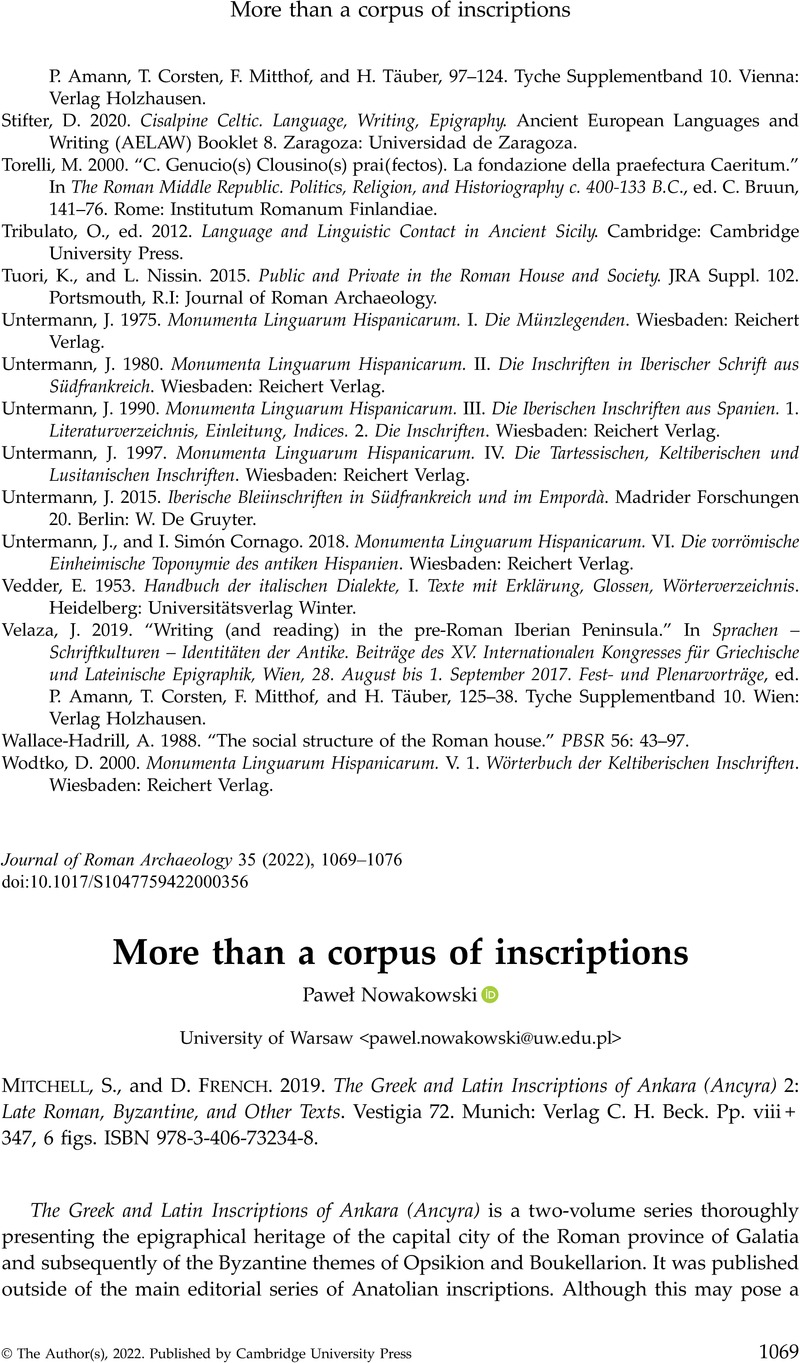No CrossRef data available.
Article contents
More than a corpus of inscriptions - S. Mitchell, and D. French. 2019. The Greek and Latin Inscriptions of Ankara (Ancyra) 2: Late Roman, Byzantine, and Other Texts. Vestigia 72. Munich: Verlag C. H. Beck. Pp. viii + 347, 6 figs. ISBN 978-3-406-73234-8.
Review products
S. Mitchell, and D. French. 2019. The Greek and Latin Inscriptions of Ankara (Ancyra) 2: Late Roman, Byzantine, and Other Texts. Vestigia 72. Munich: Verlag C. H. Beck. Pp. viii + 347, 6 figs. ISBN 978-3-406-73234-8.
Published online by Cambridge University Press: 01 December 2022
Abstract
An abstract is not available for this content so a preview has been provided. Please use the Get access link above for information on how to access this content.

- Type
- Book Review
- Information
- Copyright
- Copyright © The Author(s), 2022. Published by Cambridge University Press
References
Begass, C. 2022. Review of The Greek and Latin Inscriptions of Ankara (Ancyra), 2: Late Roman, Byzantine and Other Texts, ed. Mitchell, S. and French, D.. HZ 314, no. 1: 170–71.Google Scholar
Bosch, E. 1967. Quellen zur Geschichte der Stadt Ankara im Altertum. Ankara: Türk Tarih Kurumu Basımevi.Google Scholar
Brandes, W. 2015. “Historische Anmerkungen: Ankyra im 7.–9. Jahrhundert.” In Ankara. Die bauarchäologischen Hinterlassenschaften aus römischer und byzantinischer Zeit 1, Textband, ed. Peschlow, U., 259–65. Vienna: Phoibos Verlag.Google Scholar
Foss, C. 1985. “Ankyra.” In Reallexikon für Antike und Christentum, Supplement I, transl. Brakmann, H., 448–67. Stuttgart: A. Hiersemann.Google Scholar
Grégoire, H. 1927–28. “Inscriptions historiques byzantines. Ancyre et les Arabes sous Michel l'Ivrogne.” Byzantion 4: 437–68.Google Scholar
IAph2007 – Reynolds, J., Roueché, Ch., and Bodard, G. 2007. Inscriptions of Aphrodisias. London: Centre for Computing in the Humanities, King's College London. http://insaph.kcl.ac.uk/.Google Scholar
IG II/III2 – Kirchner, J., ed. 1913–1940. Inscriptiones Graecae II et III: Inscriptiones Atticae Euclidis anno posteriores, 2nd ed., parts I–III. Berlin: Apud G. Reimerum.Google Scholar
I. Tyr 2 – Rey-Coquais, J.-P., ed. 2006. Inscriptions grecques et latines de Tyr 2. BAAL: Bulletin d'Archéologie et d'Architecture Libanaises 3. Beirut: Ministère de la Culture, Direction Générale des Antiquités.Google Scholar
MAMA III – Keil, J., and Wilhelm, A., eds. 1931. Monumenta Asiae Minoris Antiqua 3: Denkmäler aus dem rauhen Kilikien. Manchester: Manchester University Press.Google Scholar
MAMA XI – Thonemann, P., Crowther, C., and Chiricat, E., eds. 2013. Monumenta Asiae Minoris Antiqua 11: Monuments from Phrygia and Lykaonia. London: Society for the Promotion of Roman Studies. http://mama.csad.ox.ac.uk.Google Scholar
Marek, C., and Adak, M.. 2016. Epigraphische Forschungen in Bithynien, Paphlagonien, Galatien und Pontos. Istanbul: Kabalcı Yayıncılık.Google Scholar
Nowakowski, P. 2018. Inscribing the Saints in Late Antique Anatolia. Warsaw: Raphael Taubenschlag Foundation.Google Scholar
Onur, F. 2020. Review of The Greek and Latin Inscriptions of Ankara (Ancyra), 2: Late Roman, Byzantine and Other Texts, ed. S. Mitchell and D. French. JRS 110: 374–75.Google Scholar
Osborne, M. J., and Byrne, S. G.. 1996. The Foreign Residents of Athens. An Annex to the Lexicon of Greek Personal Names: Attica. Leuven: Peeters.Google Scholar
Öztürk, H. S., and Dana, D 2021. “From Dacia Minor to Nicomedia: Iconography, onomastics and a new career of the Late Roman army. The sarcophagus of Tziampo, protector divini lateris.” Acta Classica Mediterranea 4: 29–65.Google Scholar
Peschlow, U. 2015. Ankara. Die bauarchäologischen Hinterlassenschaften aus römischer und byzantinischer Zeit, 2 vols (1: Textband; 2: Tafelband). Vienna: Phoibos Verlag.Google Scholar
Petzl, G. 2021. Review of The Greek and Latin Inscriptions of Ankara (Ancyra), 2: Late Roman, Byzantine and Other Texts, ed. S. Mitchell and D. French. Klio 103, no. 1: 399–402.CrossRefGoogle Scholar
Rhoby, A. 2021. Review of The Greek and Latin Inscriptions of Ankara (Ancyra), 2: Late Roman, Byzantine and Other Texts, ed. Mitchell, S. and French, D.. The Byzantine Review 3: 127–35.Google Scholar
Serin, U. 2017. “Late Antique and Byzantine Ankara: Topography and architecture.” In Marmoribus Vestita. Miscellanea in onore di Federico Guidobaldi, ed. Brandt, O. and Pergola, P., 1257–80. Vatican City: Pontificio Istituto di Archeologia Cristiana.Google Scholar
SEG – Supplementum Epigraphicum Graecum.Google Scholar
Studia Pontica III 1 – Anderson, J. G. C., Cumont, F., and Grégoire, H.. 1910. Studia Pontica, Vol. 3, part 1, Recueil des inscriptions grecques et latines du Pont et de l'Arménie. Brussels: Lamertin.Google Scholar
Taylor, D. 2019. “The coming of Christianity to Mesopotamia.” In The Syriac World, ed. King, D., 68–87. London: Routledge.Google Scholar
TIB – Belke, K., and Restle, M. 1984. Tabula Imperii Byzantini 4: Galatien und Lykaonien. Vienna: Verlag der Österreichischen Akademie der Wissenschaften.Google Scholar
Trombley, Fr., and Nowakowski, P.. 2018. “Appendix 4: Epigraphy.” In Archaeology and Urban Settlement in Late Roman and Byzantine Anatolia: Euchaïta-Avkat-Beyözü and its Environment, ed. Haldon, J., Elton, H., and Newhard, J., 287–322. Cambridge: CUP.Google Scholar


